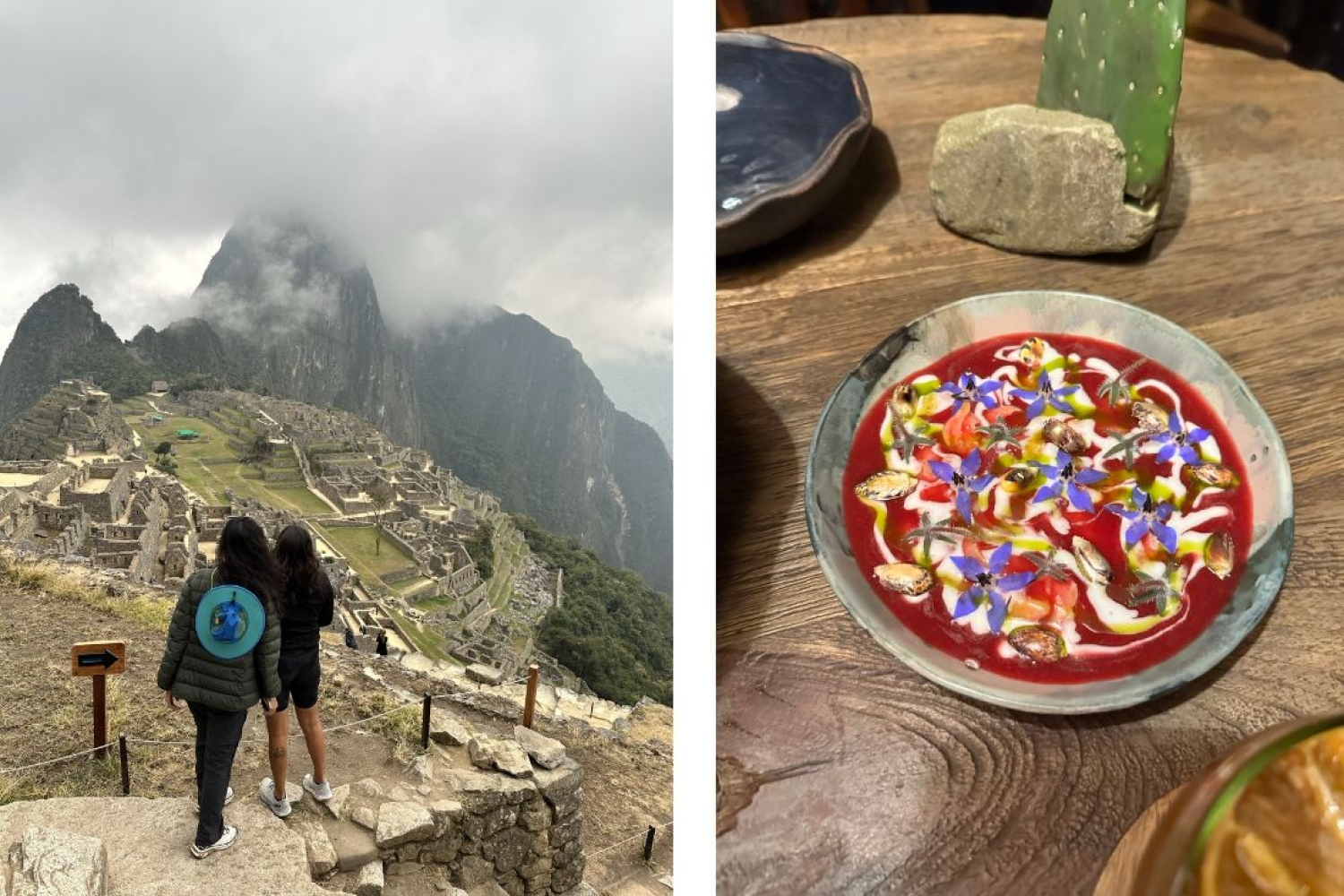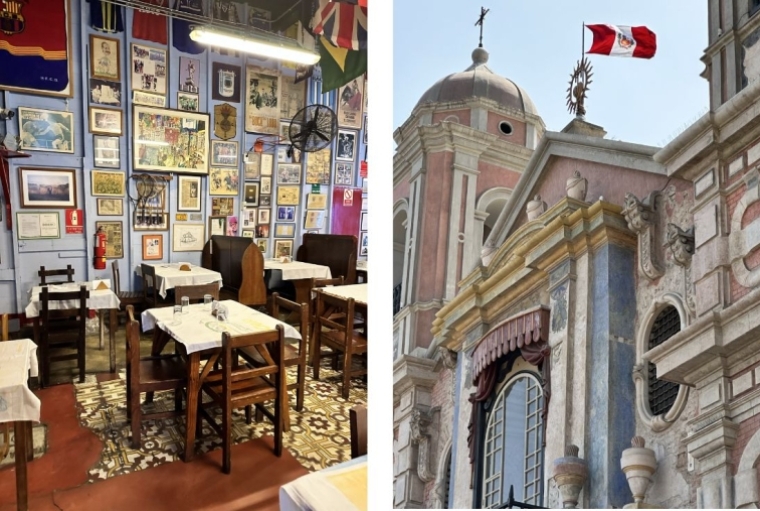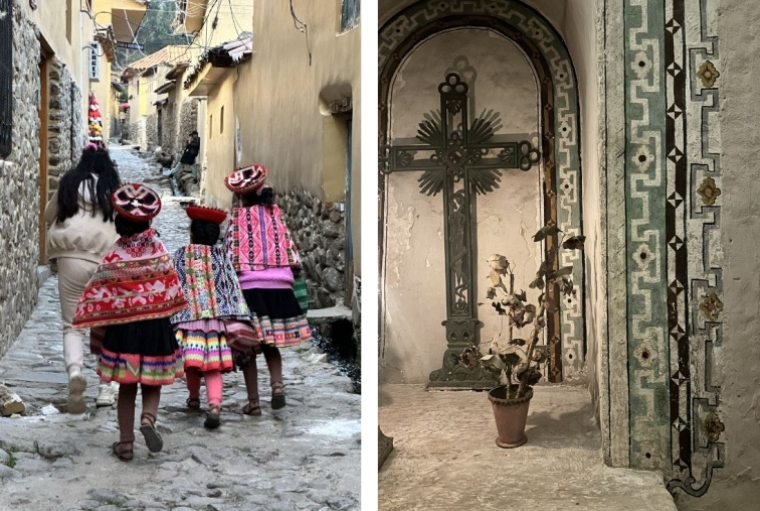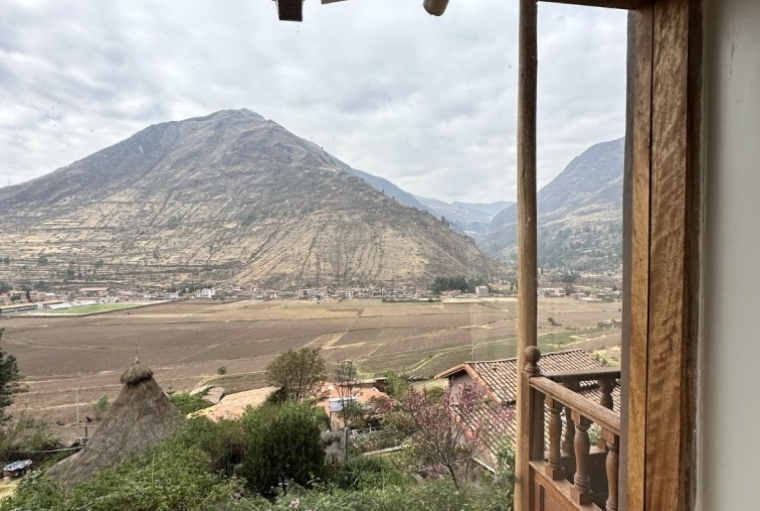

It’s 6 am, and I stand gazing at the Andean mountains. Our guide Garciela tells us we’re in a cloud forest that is a gateway to the Amazon rainforest. Within minutes, the clouds drift away to reveal the ancient ruins of Machu Picchu. Llamas graze joyfully, rolling in the grass along the terraces. Garciela explains that scientists and academics once lived here, studying the weather and worshipping the sun, moon, and stars. She mentions there was a religion of agronomists, where science married spirituality. The hairs on my arms stand on end, maybe it’s from the cold and mist or the almost ethereal energy that surrounds this place.
MACHU PICCHU
I soon realise Machu Picchu is Pachamama’s (Earth Mother) temple, one that opens into the planet’s largest trove, the Amazon. The butterflies here are unlike any I’ve ever seen. The soil is a vivid hue of red, the terraces are laden with fresh crops & fruit, and I can hear the river Urubamba gushing through this sacred valley.
Centuries ago, long before genetic modification of crops, the Incas discovered how to cultivate the highest varieties of corn and potatoes. They did this by conversing with the microclimate and its elements in this natural laboratory. This beautiful dynamic lays the foundation for Peru’s relationship with its food and agriculture.

LIMA’S GASTRONOMIC SCENE
We began our journey in Lima. We wandered through the lanes of Miraflores and Barranco, known for their unique gastronomic scene and artsy streets. The metropolitan shores kiss the South Pacific Ocean and are home to digital nomads, surfers, and global travellers.
Sleep-deprived after an overnight flight, we walked into a coffee and cacao tasting at Ciclos. Locals describe them as agricultural technicians, coffee tasters, and cacao librarians. Their passion for the beans and their farmers runs deep. We learned about the symbiotic relationship between coffee and cacao, and how their taste, smell, and appearance reflect their Peruvian origins.
Our next stop was the cevicheria (eateries that specialise in raw, cured seafood). We entered Canta Rana, which at first glance seemed like a local hole-in-the-wall. Football memorabilia from travellers and regulars covered every inch of the walls and ceiling. I imagined the countless celebrations that must have taken place here. The hostess quickly embellished our white tablecloth with chochos(beans), mai?z tostado (roasted corn), and pickled chilli—a special offering reserved for select patrons. These are made for bold texture and flavour accompaniments. Flanked by fresh corn, a slice of sweet potato, and four slivers of avocado, the raw fish and calamari glistened. We poured the golden Leche de Tigre (tiger’s milk) over it, a zesty, passionfruit-infused version unique to Canta Rana. The golden liquid transformed the raw fish into velvety perfection. The flavours and textures were unlike anything I’d experienced—and this was just the beginning.

THE HISTORY
As we strolled through Lima’s historic city centre, I wondered about the many eras these lands had lived. We spent an evening at the Bougainvillea clad Museo Larco, a private museum housing the archaeological collections from pre-Columbian Peru. I remembered watching an Anthony Bourdain episode where he explored the erotic art of the Andean societies—and here it was, right in front of me!
The ceramics and ancient paraphernalia highlighted the Andean worldview of tinkuy: the meeting of opposite yet complementary forces. Just as day turns into night, and dry seasons give way to rain, men and women come together to create life. The Chakana, or spiral, is an Incan symbol representing this never-ending cycle. Many such profound ideas were conveyed rather simply as symbols of sacred geometry.
We sipped Coca tea, enjoyed Chicha morada (a fermented beverage made from purple maize), and indulged in Dulce de leche Churros as we wandered through galleries before dinner. Though usually booked months in advance, we walked into Osaka without a reservation and were warmly welcomed to an unforgettable meal. The restaurant embodies Lima’s modern Nikkei cuisine—a fusion of Japanese techniques and Andean ingredients. Born in the late 19th century when the first Japanese immigrants arrived in Peru, this culinary style shone in the Nigiri, straight from the Pacific coast and some of the freshest I’ve ever had. Each meal deepened my appreciation for Peruvians’ connection to their food and its origins.
DESERT OASIS
On our way out of Lima we made a quick stop at the desert oasis of Huacachina. Known for its adrenaline packed sand boarding and skiing down towering sand dunes. It felt like a sunset scene straight out of Denis Villeneuve’s Dune—a one-of-a-kind experience for thrill-seekers.
From the minimal desert, we began our ascent towards the ornate colonial cities, arriving in Arequipa. The colonial Baroque architecture at nearly 5,000 feet above sea level carries the imprint of southern Spain. We hiked around the Colca Canyon, the deepest in the world, and spotted mighty Condors soaring through their natural habitat. The Santa Catalina Monastery here was built in 1580 for nuns from wealthy Spanish families, It operated under a strict vow of silence and seclusion for nearly 400 years. Wandering around this maze of cloisters, gardens of orange trees is like going back in time. It’s not only beautiful but peaceful.
I noticed the food kept getting more delicious the closer we were to the farmlands. One of the most memorable in Arequipa was our meal at 13 Monjas, their silky smooth Pisco Sours were the best we had throughout our trip. Another beautiful memory is of the warm cacao drink on a full moon evening at Chaqchao Chocolate, great for Cacao workshops and tastings.
Alqa Museo in Ollantaytambo beautifully exemplifies the intention behind food. Their vision harmonizes with ancient nutritional concepts and techniques. We enjoyed a modern yet grounded Andean meal in their gardens, paired with Peruvian natural wines. Every ingredient was thoughtfully considered, tracing its journey from farm to table.

THE ANCIENT CAPITAL OF THE INCAS
Finally acclimatised for our final ascent to 11,000 feet, we reached Cuzco, the ancient capital of the Incas and the oldest city in the Americas. The city glows with its Plaza de Armas and is effervescent at night. We met Inti & Derlis of Chikara Sushi here. Their intimate Nikkei style Izakaya called us twice and I still find myself thinking about that fresh trout.
The legendary hikes of the Inca Trail, Salcantay, and Rainbow Mountains all begin from Cuzco. The Incan ruins peek from beneath the Spanish Baroque monuments, telling stories of Kay Pacha, Uku Pacha, and Hanan Pacha—Quechua names of the deities represented by the feline, serpent, and condor. Each symbolises the material world, underworld, and the higher realms.
The more time I spent in Cuzco, the more I understood why the sacred valley is so deeply revered. The connection to life force and the gratitude for nature’s gifts is lived in each moment here. We returned with hand-coiled Copper ornaments set with earthen rocks and crystals, hoping to carry some sacred bits of this beautiful land of Pachamama.
Words Barbie Verma
Date 01.11.2024